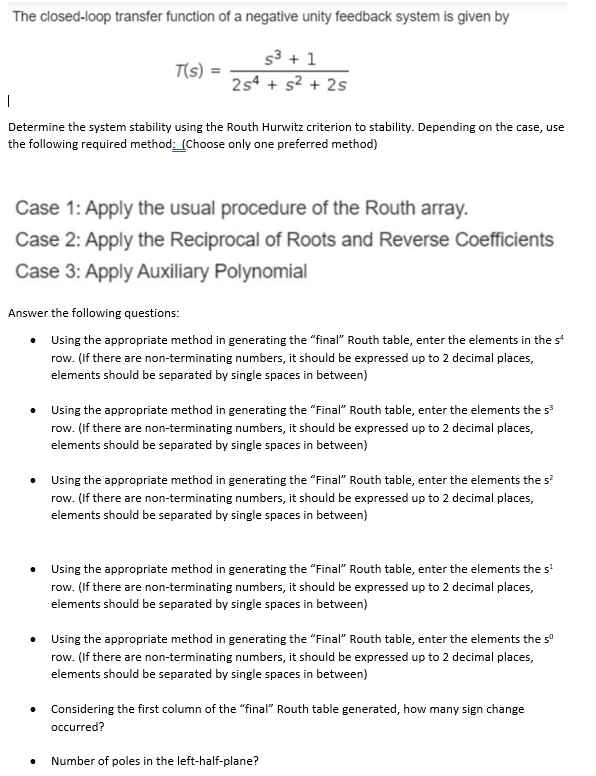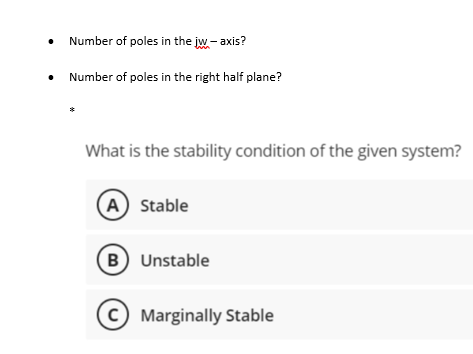The closed-loop transfer function of a negative unity feedback system is given by S³ + 1 T(s) 254 +5² + 2s | Determine the system stability using the Routh Hurwitz criterion to stability. Depending on the case, u the following required method: (Choose only one preferred method) Case 1: Apply the usual procedure of the Routh array. Case 2: Apply the Reciprocal of Roots and Reverse Coefficients Case 3: Apply Auxiliary Polynomial Answer the following questions: • Using the appropriate method in generating the "final" Routh table, enter the elements in the row. (If there are non-terminating numbers, it should be expressed up to 2 decimal places, elements should be separated by single spaces in between) • Using the appropriate method in generating the "Final" Routh table, enter the elements the s³ row. (If there are non-terminating numbers, it should be expressed up to 2 decimal places, elements should be separated by single spaces in between) • Using the appropriate method in generating the "Final" Routh table, enter the elements the s² row. (If there are non-terminating numbers, it should be expressed up to 2 decimal places, elements should be separated by single spaces in between) • Using the appropriate method in generating the "Final" Routh table, enter the elements the s¹ row. (If there are non-terminating numbers, it should be expressed up to 2 decimal places, elements should be separated by single spaces in between) • Using the appropriate method in generating the "Final" Routh table, enter the elements the sº row. (If there are non-terminating numbers, it should be expressed up to 2 decimal places, elements should be separated by single spaces in between) . Considering the first column of the "final" Routh table generated, how many sign change
The closed-loop transfer function of a negative unity feedback system is given by S³ + 1 T(s) 254 +5² + 2s | Determine the system stability using the Routh Hurwitz criterion to stability. Depending on the case, u the following required method: (Choose only one preferred method) Case 1: Apply the usual procedure of the Routh array. Case 2: Apply the Reciprocal of Roots and Reverse Coefficients Case 3: Apply Auxiliary Polynomial Answer the following questions: • Using the appropriate method in generating the "final" Routh table, enter the elements in the row. (If there are non-terminating numbers, it should be expressed up to 2 decimal places, elements should be separated by single spaces in between) • Using the appropriate method in generating the "Final" Routh table, enter the elements the s³ row. (If there are non-terminating numbers, it should be expressed up to 2 decimal places, elements should be separated by single spaces in between) • Using the appropriate method in generating the "Final" Routh table, enter the elements the s² row. (If there are non-terminating numbers, it should be expressed up to 2 decimal places, elements should be separated by single spaces in between) • Using the appropriate method in generating the "Final" Routh table, enter the elements the s¹ row. (If there are non-terminating numbers, it should be expressed up to 2 decimal places, elements should be separated by single spaces in between) • Using the appropriate method in generating the "Final" Routh table, enter the elements the sº row. (If there are non-terminating numbers, it should be expressed up to 2 decimal places, elements should be separated by single spaces in between) . Considering the first column of the "final" Routh table generated, how many sign change
Introductory Circuit Analysis (13th Edition)
13th Edition
ISBN:9780133923605
Author:Robert L. Boylestad
Publisher:Robert L. Boylestad
Chapter1: Introduction
Section: Chapter Questions
Problem 1P: Visit your local library (at school or home) and describe the extent to which it provides literature...
Related questions
Question
helppp me with clear solution pleaseee!

Transcribed Image Text:The closed-loop transfer function of a negative unity feedback system is given by
S³ + 1
T(s)
254 +5² + 2s
|
Determine the system stability using the Routh Hurwitz criterion to stability. Depending on the case, use
the following required method: (Choose only one preferred method)
Case 1: Apply the usual procedure of the Routh array.
Case 2: Apply the Reciprocal of Roots and Reverse Coefficients
Case 3: Apply Auxiliary Polynomial
Answer the following questions:
• Using the appropriate method in generating the "final" Routh table, enter the elements in the sª
row. (If there are non-terminating numbers, it should be expressed up to 2 decimal places,
elements should be separated by single spaces in between)
• Using the appropriate method in generating the "Final" Routh table, enter the elements the s³
row. (If there are non-terminating numbers, it should be expressed up to 2 decimal places,
elements should be separated by single spaces in between)
• Using the appropriate method in generating the "Final" Routh table, enter the elements the s²
row. (If there are non-terminating numbers, it should be expressed up to 2 decimal places,
elements should be separated by single spaces in between)
• Using the appropriate method in generating the "Final" Routh table, enter the elements the s¹
row. (If there are non-terminating numbers, it should be expressed up to 2 decimal places,
elements should be separated by single spaces in between)
• Using the appropriate method in generating the "Final" Routh table, enter the elements the sº
row. (If there are non-terminating numbers, it should be expressed up to 2 decimal places,
elements should be separated by single spaces in between)
• Considering the first column of the "final" Routh table generated, how many sign change
occurred?
Number of poles in the left-half-plane?

Transcribed Image Text:Number of poles in the jw-axis?
Number of poles in the right half plane?
*
What is the stability condition of the given system?
A) Stable
(B) Unstable
C) Marginally Stable
Expert Solution
This question has been solved!
Explore an expertly crafted, step-by-step solution for a thorough understanding of key concepts.
Step by step
Solved in 3 steps with 3 images

Knowledge Booster
Learn more about
Need a deep-dive on the concept behind this application? Look no further. Learn more about this topic, electrical-engineering and related others by exploring similar questions and additional content below.Recommended textbooks for you

Introductory Circuit Analysis (13th Edition)
Electrical Engineering
ISBN:
9780133923605
Author:
Robert L. Boylestad
Publisher:
PEARSON

Delmar's Standard Textbook Of Electricity
Electrical Engineering
ISBN:
9781337900348
Author:
Stephen L. Herman
Publisher:
Cengage Learning

Programmable Logic Controllers
Electrical Engineering
ISBN:
9780073373843
Author:
Frank D. Petruzella
Publisher:
McGraw-Hill Education

Introductory Circuit Analysis (13th Edition)
Electrical Engineering
ISBN:
9780133923605
Author:
Robert L. Boylestad
Publisher:
PEARSON

Delmar's Standard Textbook Of Electricity
Electrical Engineering
ISBN:
9781337900348
Author:
Stephen L. Herman
Publisher:
Cengage Learning

Programmable Logic Controllers
Electrical Engineering
ISBN:
9780073373843
Author:
Frank D. Petruzella
Publisher:
McGraw-Hill Education

Fundamentals of Electric Circuits
Electrical Engineering
ISBN:
9780078028229
Author:
Charles K Alexander, Matthew Sadiku
Publisher:
McGraw-Hill Education

Electric Circuits. (11th Edition)
Electrical Engineering
ISBN:
9780134746968
Author:
James W. Nilsson, Susan Riedel
Publisher:
PEARSON

Engineering Electromagnetics
Electrical Engineering
ISBN:
9780078028151
Author:
Hayt, William H. (william Hart), Jr, BUCK, John A.
Publisher:
Mcgraw-hill Education,